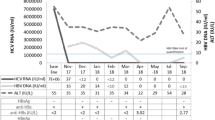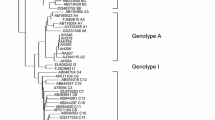Abstract
Reactivation of hepatitis B virus (HBV) in HBV surface antigen (HBsAg)-positive patients treated with cytotoxic chemotherapy is well known. HBV reactivation in patients with HBV and hepatitis C virus (HCV) coinfection caused by direct-acting antiviral (DAA) therapy has also recently been reported. We report a case of acute hepatitis B in a patient with HCV infection after DAA therapy. An 83-year-old woman was referred for chronic hepatitis C. She was infected with HCV genotype 1b and negative for HBsAg at baseline. She received daclatasvir and asunaprevir therapy, and HCV became negative at 4 weeks and remained negative until 6 months after the end of DAA therapy. Acute hepatitis B developed 5 months after ending DAA therapy. Genome sequencing revealed the subgenotype as B1, and the serological subtype as adr. T118 K mutation at the S region as an immune escape mutant was identified. These virologic features led to HBV reactivation. The presence of hepatitis B core antibody or HBs antibody was not determined before DAA therapy, so prior HBV infection status was unclear. This case is speculated to represent HBV reactivation in a patient with previously resolved HBV induced by DAA therapy, based on virologic analysis and clinical status. The risk might be very low, but DAA therapy can cause HBV reactivation in chronic hepatitis C patients with prior HBV infection. When acute hepatitis emerges in patients who have received DAA therapy for HCV, HBV reactivation should be considered to allow early initiation of anti-HBV therapy.



Similar content being viewed by others
References
Kao JH, Chen DS. Global control of hepatitis B virus infection. Lancet Infect Dis. 2002;2:395–403.
Ott JJ, Stevens GA, Groeger J, Wiersma ST. Global epidemiology of hepatitis B virus infection: new estimates of age-specific HBsAg seroprevalence and endemicity. Vaccine. 2012;30:2212–9.
Ganem D, Prince AM. Hepatitis B virus infection—natural history and clinical consequences. N Engl J Med. 2004;350:1118–11129.
Dervite I, Hober D, Morel P. Acute hepatitis B in a patient with antibodies to hepatitis B surface antigen who was receiving rituximab. N Engl J Med. 2001;344:68–9.
Wands JR, Chura CM, Roll FJ, Maddrey WC. Serial studies of hepatitis associated antigen and antibody in patients receiving antitumor chemotherapy for myeloproliferative and lymphoproliferative disorders. Gastroenterology. 1975;68:105–12.
Galbraith RM, Eddleston AL, Williams R, Zuckerman AJ. Fulminant hepatic failure in leukaemia and choriocarcinoma related to withdrawal of cytotoxic drug therapy. Lancet. 1975;2:528–30.
Collins JM, Raphael KL, Terry C, et al. Hepatitis B virus reactivation during successful treatment of hepatitis C virus with sofosbuvir and simeprevir. Clin Infect Dis. 2015;61:1304–6.
Takayama H, Sato T, Ikeda F, Fujiki S. Reactivation of hepatitis B virus during interferon-free therapy with daclatasvir and asunaprevir in patient with hepatitis B virus/hepatitis C virus co-infection. Hepatol Res. 2016;46:489–91.
Chayama K, Takahashi S, Toyota J, et al. Dual therapy with the nonstructural protein 5A inhibitor, daclatasvir, and the nonstructural protein 3 protease inhibitor, asunaprevir, in hepatitis C virus genotype 1b-infected null responders. Hepatology. 2012;55:742–8.
Lawitz E, Poordad FF, Pang PS, et al. Sofosbuvir and ledipasvir fixed-dose combination with and without ribavirin in treatment-naive and previously treated patients with genotype 1 hepatitis C virus infection (LONESTAR): an open-label, randomised, phase 2 trial. Lancet. 2014;383:515–23.
AASLD/IDSA HCV Guidance Panel. Hepatitis C guidance: AASLD-IDSA recommendations for testing, managing, and treating adults infected with hepatitis C virus. Hepatology. 2015;62:932–54.
Umemura T, Tanaka E, Kiyosawa K, Kumada H, Japan de novo Hepatitis B Research Group. Mortality secondary to fulminant hepatic failure in patients with prior resolution of hepatitis B virus infection in Japan. Clin Infect Dis. 2008;47:e52–6.
Liu CJ, Chen PJ, Chen DS, et al. Hepatitis B virus reactivation post-cancer chemotherapy: pathogenesis and management. Hepatol Int. 2013;7:316–26.
Kusumoto S, Tanaka Y, Suzuki R, et al. Monitoring of hepatitis B virus (HBV) DNA and risk of HBV reactivation in B-cell lymphoma: a prospective observational study. Clin Infect Dis. 2015;61:719–29.
Uchida Y, Kouyama J, Naiki K, Mochida S. A novel simple assay system to quantify the percent HCV-RNA levels of NS5A Y93H mutant strains and Y93 wild-type strains relative to the total HCV-RNA levels to determine the indication for antiviral therapy with NS5A inhibitors. PLoS One. 2014;9(11):e112647.
Tamada Y, Yatsuhashi H, Masaki N, et al. Hepatitis B virus strains of subgenotype A2 with an identical sequence spreading rapidly from the capital region to all over Japan in patients with acute hepatitis B. Gut. 2012;61:765–73.
Yotsuyanagi H, Okuse C, Yasuda K, et al. Distinct geographic distributions of hepatitis B virus genotypes in patients with acute infection in Japan. J Med Virol. 2005;77:39–46.
Hayashi K, Katano Y, Takeda Y, et al. Comparison of hepatitis B virus subgenotypes in patients with acute and chronic hepatitis B and absence of lamivudine-resistant strains in acute hepatitis B in Japan. J Med Virol. 2007;79:366–73.
Salpini R, Colagrossi L, Bellocchi MC, et al. Hepatitis B surface antigen genetic elements critical for immune escape correlate with hepatitis B virus reactivation upon immunosuppression. Hepatology. 2015;61:823–33.
Colson P, Borentain P, Coso D, et al. Hepatitis B virus reactivation in HBsAg-negative patients is associated with emergence of viral strains with mutated HBsAg and reverse transcriptase. Virology. 2015;484:354–63.
Hayashi K, Ishigami M, Ishizu Y, et al. Clinical characteristics and molecular analysis of hepatitis B virus reactivation in hepatitis B surface antigen-negative patients during or after immunosuppressive or cytotoxic chemotherapy. J Gastroenterol. 2016 [Epub ahead of print].
Kramvis A. Genotypes and genetic variability of hepatitis B virus. Intervirology. 2014;57:141–50.
Kamitsukasa H, Iri M, Tanaka A, et al. Spontaneous reactivation of hepatitis B virus (HBV) infection in patients with resolved or occult HBV infection. J Med Virol. 2015;87:589–600.
Mochida S, Nakao M, Nakayama N, et al. Nationwide prospective and retrospective surveys for hepatitis B virus reactivation during immunosuppressive therapies. J Gastroenterol. 2016 [Epub ahead of print].
Sagnelli E, Coppola N, Marrocco C, et al. Hepatitis C virus superinfection in hepatitis B virus chronic carriers: areciprocal viral interaction. J Clin Virol. 2006;35:317–20.
De Monte A, Courjon J, Anty R, et al. Direct-acting antiviral treatment in adults infected with hepatitis C virus: reactivation of hepatitis B virus coinfection as a further challenge. J Clin Virol. 2016;78:27–30.
Saxena V, Nyberg L, Pauly M, et al. Safety and efficacy of simeprevir/sofosbuvir in hepatitis C-infected patients with compensated and decompensated cirrhosis. Hepatology. 2015;62:715–25.
Author information
Authors and Affiliations
Corresponding author
Ethics declarations
Conflict of interest
Hidemi Goto received a research grant from Astra Zenaca, Astellas Pharma, Ajinomoto Pharmaceutical Co, Bristol-Myers Squibb, Chugai Pharmaceutical Co, Daiichi Sankyo, Dainippon Sumitomo Pharma, Eisai, Mitsubishi Tanabe Pharma, MSD, Otsuka Pharmaceutical Co, and Takeda Pharmaceutical Co.
Human rights
All procedures followed have been performed in accordance with the ethical standards laid down in the 1964 Declaration of Helsinki and its later amendments.
Informed consent
Informed consent was obtained from all patients for being included in the study.
Rights and permissions
About this article
Cite this article
Hayashi, K., Ishigami, M., Ishizu, Y. et al. A case of acute hepatitis B in a chronic hepatitis C patient after daclatasvir and asunaprevir combination therapy: hepatitis B virus reactivation or acute self-limited hepatitis?. Clin J Gastroenterol 9, 252–256 (2016). https://doi.org/10.1007/s12328-016-0657-4
Received:
Accepted:
Published:
Issue Date:
DOI: https://doi.org/10.1007/s12328-016-0657-4




